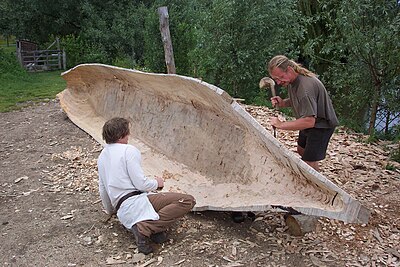AY Honors/Canoe Building/Answer Key
1. What trees in your area are used for building canoes? Name them in your language. Are they considered softwoods or hardwoods?
In the Pacific Islands, dugout canoes are very large, made from whole mature trees and fitted with outriggers for increased stability in the ocean, and were once used for long-distance travel. Such are the very large waka used by Māori who ventured to New Zealand many centuries ago. Such vessels carried 40 to 80 warriors in sheltered waters or smaller numbers thousands of miles across the Pacific ocean. In Hawaii, canoes are traditionally manufactured from the trunk of the koa (Acacia koa) tree. They typically carry a crew of six: one steersman and five paddlers.
In Africa, African Teak is the timber favored for their construction, though this comprises a number of different species, and is in short supply in some areas.
2. What trees are used for building canoes, softwoods or hardwoods?
Canoes are made from both, depending on the regional preferences.
Trees belonging to the genus Acacia are used in both the South Pacific and in Africa. Acacias are hardwoods. Canoes were made in the Pacific Northwest of North America from Douglas fir, which is a softwood. In eastern North America, dugouts were made from chestnut, tulip tree (both hardwoods), or pine (a softwood). In Venezuela, the Ye'kwana make canoes from Spanish Cedar (Cedrela odorata) which is another softwood.
3. What tools are used for building canoes? Start with felling the tree up to completion.
- Ax
- Machete
- Adze
- Scrapers
- Wedges (to hold the canoe in place)
- Scaffolding
- Drill and bit
4. Choose a good canoe tree about four meters in length and observe the correct felling of it. Explain what happened.
The Wampanoag (a Native American tribe) felled canoe trees by packing mud around the trunk and building a fire around the base. The mud would prevent the upper portion of the trunk from burning while the lower portion was consumed. Eventually, the tree would fall.
Other cultures simply cut the tree down with an ax. In doing this, care must be taken to control the direction in which the tree falls when it comes down. This is done by cutting a notch on the side corresponding to the direction of fall. This notch should be cut until it is just over half way through the trunk. Then another notch is cut on the other side, but higher than the first.
5. Describe how a log is prepared to build a canoe.
First the log is cut to the desired length and the bark is removed from the exterior.
In South America, the bulk of the hollowing of the trunk is done right where the tree falls. It is turned in place until the portion of the trunk that will become the keel is on the ground, and then rocks, dirt, and other debris are packed around the trunk to keep it from rolling. The tree is then mostly hollowed out with adzes. This is done to reduce the weight of the log before an attempt is made to drag it out of the jungle.
6. With the help of others properly shape the outside of the canoe and hollow out the inside. Correctly smooth both surfaces inside and outside.
Before the appearance of metal tools, dugouts were hollowed-out using controlled fires. The burnt wood was then removed using an adze. Another method using tools is to chop out parallel notches across the interior span of the wood, then split out and remove the wood from between the notches. Once hollowed out, the interior is dressed and smoothed out with a knife or adze.
The ends are tapered to reduce drag in the water.
To shape the hull so that it has an even thickness, bore several small, evenly spaced holes in the hull. These are then plugged with pegs, the length of which equals the desired thickness of the hull. The pegs are inserted from the outside until they are flush with the surface of the hull. The inside is then hollowed until the ends of the pegs are reached. When the boat is placed in the water, the pegs will swell and the holes will be water-tight.
As the hull becomes thin, the canoe is inverted over a fire to heat the wood, making it more pliable. The gunwales are then spread apart, greatly increasing the interior room in the craft. Spacers are then placed over the gunwales to hold them apart as the log cools, and the boat retains this shape.

